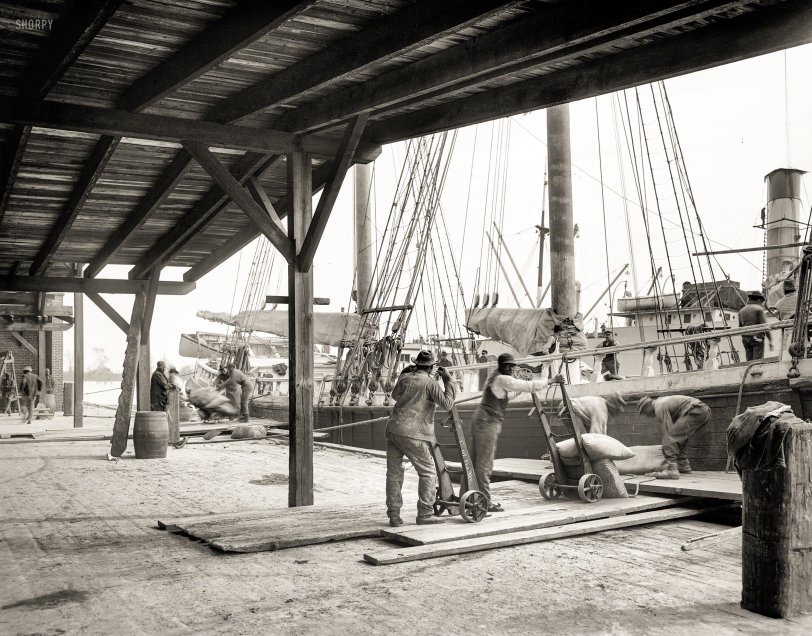


Framed or unframed, desk size to sofa size, printed by us in Arizona and Alabama since 2007. Explore now.
Shorpy is funded by you. Patreon contributors get an ad-free experience.
Learn more.

- Baldwin 62303
- Baldwin VO-1000
- Cold
- No expense spared
- Tough Guys
- Lost in Toyland
- And without gloves
- If I were a blindfolded time traveler
- Smoke Consumer Also Cooks
- Oh that stove!
- Possibly still there?
- What?!?
- $100 Reward
- Freeze Frame
- Texas Flyer wanted
- Just a Year Too Soon
- WWII -- Replacing men with women at the railroad crossing.
- Yes, Icing
- You kids drive me nuts!
- NOT An Easy Job
- I wonder
- Just add window boxes
- Icing Platform?
- Indiana Harbor Belt abides
- Freezing haze
- Corrections (for those who care)
- C&NW at Nelson
- Fallen Flags
- A dangerous job made worse
- Water Stop
Print Emporium
Heavy Lifting: 1906

Savannah, Georgia, circa 1906. "Loading a phosphate schooner." 8x10 inch dry plate glass negative, Detroit Publishing Company. View full size.
Talmadege Bridge Area
The photo's current location, was long since buried by the Talmadge Bridge.
At the time the photo was taken, Central of Georgia accessed the port area by means of a track embedded in River Street. It's entirely possible that this particular dock was owned by the railroad itself, and served for trans-shipment. Meaning goods were transferred from ship to rail for distribution.
I believe that the notched board is some kind of bumper, being lowered between the ship and dock itself, with the notches serving as a way for it to grip the dock, while offering different depths, depending on how the ship bowed on the side of the hull.
Railroad Carts
The two hand carts closest to camera are stenciled for the Central of Georgia Railway, which at one time had a significant presence in Savannah. My grandfather had just begun working for the Central around the time of this photo.
Buenos notches
Does anyone have any idea what the large timber leaning against the pillar at the left is used for? It has a series of fairly regular notches cut into one side like it was used to prop something in place.
Unloading Actually
Sack truck on left is heading away from vessel.
Empty sack truck on right is waiting for one in
front of it to be loaded.
Loading?
*Unloading* seems more likely, unless that fellow with the empty dolly is being especially unhelpful.
Identify this ship?
The ship in the photo has a railing on turned stanchions almost its whole length. This is a very unusual feature in American schooners, and in principle ought to be a clue to the ship's identity.
In Howard I. Chapelle's "History of American Sailing Ships," there is only one example of such a feature: the Howard Smith, built in Boston in 1888. Not saying this is a photo of that ship -- Smith was a 4-master and this ship seems to have only 3 masts judging by the sheer line. But an expert in coasting schooners might well be able to identify the ship using this clue.
By the turn of the century, most coasting schooners were Maine-built and had this type of railing only around the quarterdeck or "riz deck" (somehow, a contraction of "raised" in period slang).
























On Shorpy:
Today’s Top 5